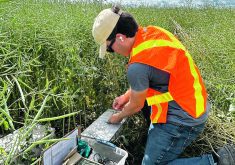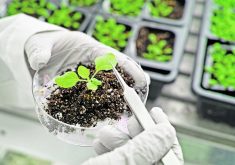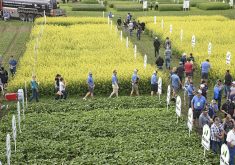Will Canadian researchers ever again revolutionize agriculture as they did by developing canola? The Western Producer’s Robert Arnason poses that question in this special report. Agriculture research today is mostly a collaboration of public, corporate and industry resources focused on practical, incremental advances. Some argue that narrow funding horizons and changing priorities rule out big thinking. Others say the long journey to innovation is achieved through many steps. Next week, read about an example of visionary ag research: nitrogen fixing cereals.
Forty-five years ago, Keith Downey heard about a new machine that could accurately detect the amount of oil in a kernel of corn.
Read Also

VIDEO: Agritechnica Day 4: Robots and more robots, Nexat loves Canada and the trouble with tariffs
Agritechnica Day 4: Robots and more robots, Nexat loves Canada and the trouble with tariffs.
At the time, the Agriculture Canada plant scientist was attempting to enhance the oil profile of rapeseed through selective breeding.
He thought the machine would be useful because he needed a rapid and reliable test to assess the oil properties of rapeseed.
Downey wrote a letter to the director general of Agriculture Canada’s research branch, requesting funding for the equipment.
In a matter of weeks, the director authorized the purchase and Downey had a $35,000 machine for his rapeseed project at the Saskatoon research station.
“Which would be a few hundred thousand now,” he said. “And it worked like a charm.”
Downey, who went on to help develop canola, said the story illustrates how drastically different things once were for agricultural scientists.
“If we came up with a good idea, you were able to sell it at the top.”
Downey said there was a fundamental shift within Agriculture Canada in the 1990s, which according to him now obstructs innovation and groundbreaking science.
He said Agriculture Canada scientists with novel ideas now have to convince a multitude of players to back the proposal, including federal administrators, non-government organizations and in particular, crop science companies.
“The client for Agriculture Canada (used to be) the producer. Today the client is the multinationals and the industry,” Downey said.
“That changed in the 1990s. That was a major tactical error. The support (for) agriculture research should come from the ground up. That change tended to say, do this research from the top down. That’s a killer.”
Wilf Keller, president of Ag-West Bio, which promotes the bio-science economy, said the existing funding model discourages pioneering science that led to breakthroughs such as canola.
Following severe federal budget cuts to agriculture research in the 1990s, Agriculture Canada bureaucrats devised new funding rules that would force government scientists to partner with crop science companies and other organizations on projects.
With industry money on the line, researchers were pushed towards practical, achievable projects. Keller said the strategic shift to applied research and away from fundamental science has come with a cost.
“No one goes in on their own (anymore). Many, many programs are 50-50 funding, or consortiums,” Keller said.
“In order to develop a work plan for a consortium, you’re going to have to satisfy all those consortium members…. (So) you take the lowest level of risk…. You end up with the lowest common denominator.”
Downey said it’s difficult to advance research when funders support Project A and then abandon it for Project X three years later.
“You can even see it in the much larger picture, where NRC (National Research Council) is right out of canola,” said Downey.
“The people working their butts off in the canola area and had things coming forward, all of a sudden they’re told, ‘drop it and pick this other (research) up….’ If you want to shift emphasis, that’s OK. But you don’t do it from one year to the next 100 percent.”
Downey said there are a few encouraging signs within Canadian agricultural research. Carinata could potentially become a significant crop on the Prairies, and the growth of pulses has been a tremendous success.
Still, the philosophical shift toward applied agricultural research will curtail Canada’ ability to deliver blockbuster innovations, he said.
“We’re rapidly losing out, in my opinion,” he said.
“Our ability to fund serendipity research and basic research that would develop into something that is really groundbreaking and outstanding has really got to a really low level.”
The government announced cuts to Agriculture Canada research programs in 2012 and 2013 that included:
- shutting down the Cereal Research Centre in Winnipeg
- consolidating beef research in Western Canada and cancelling beef programs in Manitoba and British Columbia
- consolidating dairy research at Lennoxville, Que., and closing the dairy program at Agassiz, B.C.
- closing a number of smaller field stations
In its 2013-2014 report on plans and priorities, Agriculture Canada said it spent $358.2 million on science, innovation and adoption in the 2012-13 budget year. The department estimated that would drop to $325.8 million in 2013-14 and $272.5 million in 2014-15. The cuts were part of a 2012 government mandate to reduce all Agriculture Canada spending by 10 percent, or about $310 million.
The federal government introduced Growing Forward 2 last year, a five-year agricultural policy focused on innovation, competitiveness and markets. The combined financial commitment, backed by federal and provincial governments, is $3 billion.
Stephen Morgan Jones, a former Agriculture Canada director general for science and technology on the Prairies, said scientists often grumble about insufficient funding, but the financial reality isn’t that grave.
“If you look at the Growing Forward numbers … if you look at the investment by government … I think a lot of people would say there is a large amount of money going into agricultural research and development,” said Morgan Jones.
“I don’t think there’s a real shortage of money…. Some people would shoot me for saying that, but I think researchers today are better funded than they were 20 years ago…. When I graduated and started as a scientist, if you had two technicians you felt you couldn’t be doing any better. Now we see scientists with multiple post-doctoral fellows (on their teams).”
Morgan Jones said there are enough talented scientists within Agriculture Canada, the universities and private industry to develop another revolutionary crop such as canola.
Still, he remains concerned about research priorities. There should be a balance between long-term, fundamental science and applied research, he added, but the scale is now tilted to short-term objectives.
“It’s really only government that can look at the longer-term picture and look at the five to 15 year horizon,” he said.
“We do need to be very careful about the longer-term, high risk work.”
Reno Pontarollo, president of Genome Prairie, a non-profit organization that funds research in genomics and biosciences, agreed a model that funds scientists for a few years is restrictive.
Scientists must dedicate an immense amount of time to writing funding proposals, and it’s difficult to retain qualified help when contracts last only two or three years.
“If you’ve got a good technician … you want to keep him around,” Pontarollo said.
“If you don’t have a long-term stable funding system, it makes that difficult.”
Downey agreed, saying it’s nearly impossible for today’s scientists to have a long-term vision.
“Now you are tied to that three or five year (project) and hope you get something in the next three or five, but it’s cut so fine that you don’t have any time or resources to look to the future. That’s the main problem.”
Genome Canada, which oversees Genome Prairie and other regional bodies, is supporting higher risk science by developing a program to fund “disruptive” research, Pontarollo said.
“Genome Canada will be launching that program this year…. These are proof of concept type stuff that a single lab research can go for.”
Pontarollo said funders should lengthen the time frames of agricultural research projects.
For instance, funders don’t need to control every aspect of the research if a plant breeder wants to study wheat with a starch profile more suitable for people with gluten-intolerance.
“Whether (the scientist) is doing front end genetics, downstream breeding, working on developing a market analysis … he could use that money to do that … but he doesn’t have to (provide) detailed, painstaking descriptions of how he would do each experiment,” Pontarollo said.
“I personally would like to see more of a system where a researcher puts in more of a five to 10 year plan to work in a general area.”
Pontarollo also said agriculture and food is dramatically underfunded compared to a sector such as medicine.
Government and industry need to realize that healthy food is preventive medicine, he said.
“I think agriculture research, in general, should be funded at a level equal to or higher than health (research),” Pontarollo said.
“Everybody has to have a good quality of food available to them to be healthy…. A good, safe and reliable food supply can help us deal with many of the health issues we have now.”















